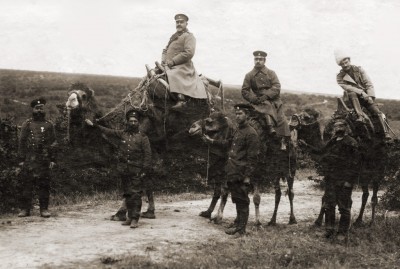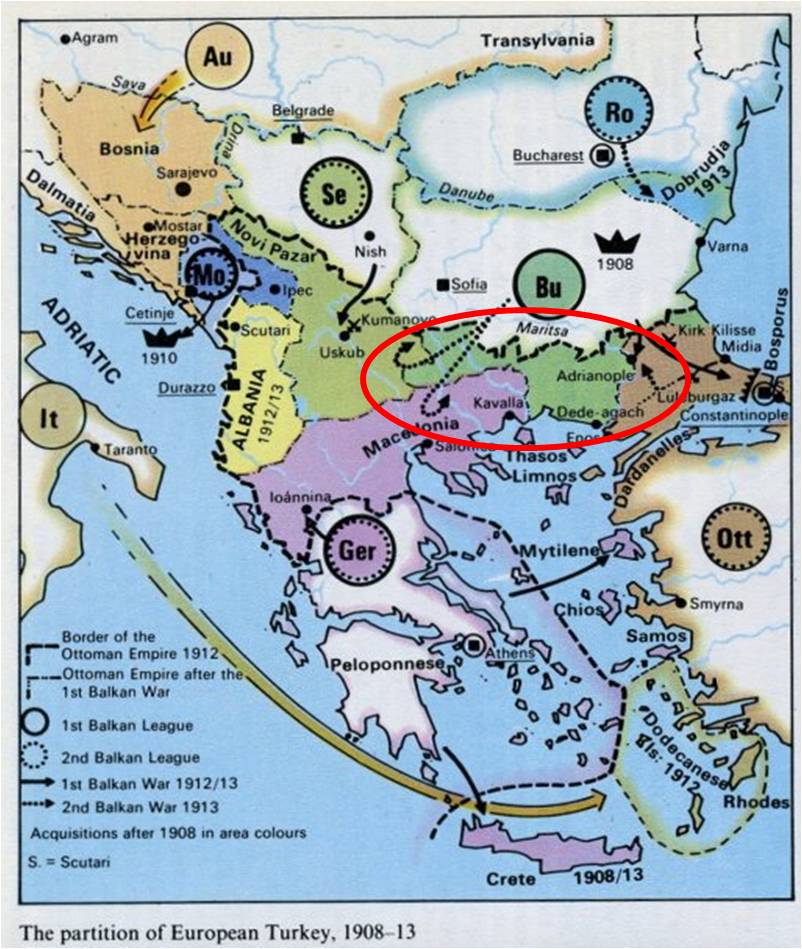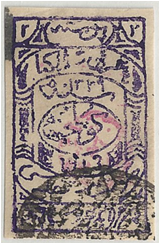ALBUM – View my Western Thrace album
Fast Facts
Region: Balkans
Group: Balkan Wars
Classification: Revolution
Prior Regime: Kingdom of Bulgaria
Key Dates:
1913, Aug 31/Sep 1 – Rebellion and formation of the Provisional Government of Western Thrace
1913, Sep 25 – The leadership renamed changed the name to the Independent Government of Western Thrace
1913, Oct 25 – Bulgarian forces assumed control of Western Thrace
Following Regime: Kingdom of Bulgaria
Scott Catalogue: (Thrace) #5-33
Pick Catalogue: none
Currency: 40 paras = 1 piaster
History

In 1878, Northern Thrace was made into the province of Eastern Rumelia, which was annexed by the recently established Kingdom of Bulgaria in 1885. The terms Eastern Thrace and Western Thrace were used for the territories east and west of the Maritsa (Meriç) River.
During the First Balkan War (1912-1913), the Balkan League (Serbia, Greece, Bulgaria and Montenegro) fought against the Ottoman Empire and annexed most of its European territory, including Adrianople (Edirne).
After gaining large amounts of territory from Ottoman Empire, Bulgaria, dissatisfied with its portion of the lands in the First Balkan War, and especially with Greek and Serbian gains in Macedonia, launched an attack on its former allies in June 1913. The attacks were driven back, and the Greek and Serbian armies invaded Bulgarian-held territory in return. At the same time, the Ottomans advanced into Eastern Thrace and retook Adrianople, while Romania used the opportunity to invade Bulgaria from the north and advance against little opposition to within a short distance of the Bulgarian capital, Sofia. Isolated and surrounded by a more powerful coalition of opponents, Bulgaria was forced to agree to a truce and to peace negotiations to be held in the Romanian capital, Bucharest. The treaty of Bucharest did not give the Bulgarians what they wished, territories in Macedonia, they were however awarded Western Thrace.
 On 31 Aug. and 1 Sep. 1913, the Turks in the region, under the leadership of Kuscubasi Esref, rose up against in Gumulcine and Iskece. The “revolutionaries” declared the formation of the Provisional Government of Western Thrace. During this time, Greek forces continued to occupy its major cities, Porto Lagos, Komotini and Alexandroupolis. The revolution declared their independence on 25 Sept, 1913 renamed the movement to be the Independent Government of Western Thrace.
On 31 Aug. and 1 Sep. 1913, the Turks in the region, under the leadership of Kuscubasi Esref, rose up against in Gumulcine and Iskece. The “revolutionaries” declared the formation of the Provisional Government of Western Thrace. During this time, Greek forces continued to occupy its major cities, Porto Lagos, Komotini and Alexandroupolis. The revolution declared their independence on 25 Sept, 1913 renamed the movement to be the Independent Government of Western Thrace.
While Bulgaria agreed with the Balkan nations they still needed to come to a separate agreement with the Ottoman Empire to firm the borders to the south. The Treaty of Constantinople (29 Sept. 1913), removed the last obstacles and the Bulgarian Army entered the region on 25-30 October, thus ending the Autonomous Government. The region remained as a part of Bulgaria until the end of World War 1 when it was taken under French protection, and ultimately awarded to and annexed by Greece in 1920.
Stamps
 ALBUM
ALBUM
During this short timeframe, the government issued 4 different sets of postage stamps. One set consisted of a set referred to as the “Muhtariyet” issues, meaning ”autonomous” in english. The stamps were simple, printed in Turkish, with the date “1913” and the denominiation also printed in Roman characters. The first two stamps were issued with the inscription “Provisional Governement”, but the rest were changed to “Autonomous Government”. The stamps were printed with a control mark: a red circle (in Gumuldjina) or an oval (in Dedeagatch).
Additionally, stamps of the Ottoman Empire were surcharged 1p on various different denominations, and stamps of Bulgaria and Greece were handstamped with a surcharge of various denominations. The surcharge for these issues were made with a handstamp which required two parts. According to Scott, one or both of the parts can be found inverted, double or omitted.
Banknotes
none
Links
Western Thrace Autonomous Govenment “Muhtariyet” Issue (1913)




